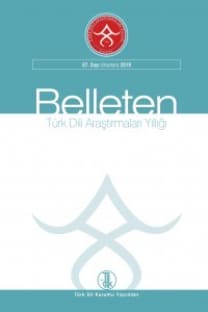Tunyukuk Yazıtı’nın 51. Satırı Üzerine
Tunyukuk Yazıtı hâlâ dik duran iki dikili taştan oluşuyor. Daha büyük olan birinci taş 35 satırlık bir yazıt içeriyor. Daha küçük olan ikinci taşta ise 27 satır vardır. Bu yazıtın büyük kısmı iyi anlaşılıyor. Hâlbuki 51. satır daha bu yazıt bulunduğunda ciddi bir şekilde tahrip olmuş durumdaydı. 51. satırdaki cümleler yayınlarda farklı çıkıyor. Araştırmacıların çoğuna göre, bu satırda iki cümle vardır. Çin vakayinamelerine göre, Kapgan Kağan, Elteriş Kağan’ın (= Kutlug) küçük erkek kardeşlerinden biri olup onun tarafından şad atanmıştır; Kapgan Kağan 27 yaşındayken Kutlug hastalıktan ölmüştür; Kapgan Kağan, küçük erkek kardeşini sol kanadın [yani, Tӧlis’lerin] şad’ı ve Kutlug’un oğlunu [yani, gelecekteki Bilgä Kağan’ı] sağ kanadın [yani, Tarduş’ların] şad’ı atamıştır. Dolayısıyla, eğer biz Radloff’un metnini kabul edersek birinci cümle şöyle tamir olarak okunabilir: :iTR[dw:azUndobSiLOT:]aF[qdCumngk:]akSj:ztoiTJ:ngkngpk ḲapŞan ḳaŞan : y(e)ti ot(u)z : yaşḳa [ḳaŞan(ï)m uçdoḳ(ï)]nta [tӧlis bod(u)n üzä şad] ärti : “Kapgan Kağan, yirmi yedi yaşında [kağanım vefat ettiği]nde [Tӧlis halkı üzerine şad] idi”. Olor- eyleminin geçmiş zamanı, olortı veya olortum’dur, olordı veya olordum değildir. Alyılmaz’a göre, ikinci cümlenin son kısmı :md, yani -d(ï)m veya -d(u)m’dur. Bu yüzden ikinci cümle, daha Aalto’nun gösterdiği gibi, :mdtrlo:ngkngpk olmalı, :idrlo:ngkngpk olmamalıdır. Bu cümle ḳapŞan ḳaŞan : ol(o)rtd(u)m : “Kapgan Kağan’ı tahta oturttum” okunabilir
ON THE 51ST LINE OF THE TUÑUQUQ INSCRIPTION
The Tuñuquq inscription consists of the stone steles which are still standing. The first and bigger stone contains an inscription of 35 lines. There are 27 lines on the second and smaller stone. Most parts of this inscription are well understood. However, the 51th line was already severely damaged when this inscription was discovered. The sentences in the 51th line appear differently in the publications. According to most researchers, there are two sentences in this line. According to the Chinese chronicles, Qapγan Qaghan was one of the younger brothers of Elteriš Qaghan (= Qutluγ) and appointed as šad by him; Qutluγ died of a disease when Qapγan Qaghan was at the age of twenty-seven; Qapγan Qaghan appointed his younger brother as the Shad of the left wing [i.e. the Tӧlis people] and the son of Qutluγ [i.e. Bilgä Qaghan of the future] as the Shad of the right wing [i.e. the Tarduš people]. Therefore, the first sentence may be mended and read as follows, if we accept the text by Radloff: :iTR[dw:azUndobSiLOT:]aF[qdCumngk:]akSj:ztoiTJ:ngkngpk Qapγan qaγan : y(e)ti ot(u)z : yašqa [qaγan(ï)m učdoq(ï)]nta [tӧlis bod(u)n üzä šad] ärti : “Qapγan Qaghan, at (the age of) twenty-seven, was [the Shad above the Tӧlis people] when [my qaghan died]”. The past tense of the verb olor- is olortï or olortum, not olordï or olordum. According to Alyılmaz, the last part of the second sentence is :md, i.e. -d(ï)m or -d(u)m. Therefore, the second sentence should be :mdtrlo:ngkngpk as Aalto already showed, not :idrlo:ngkngpk. This sentence can be read as qapγan qaγan : ol(o)rtd(u)m : “I enthroned Qapγan Qaghan”
